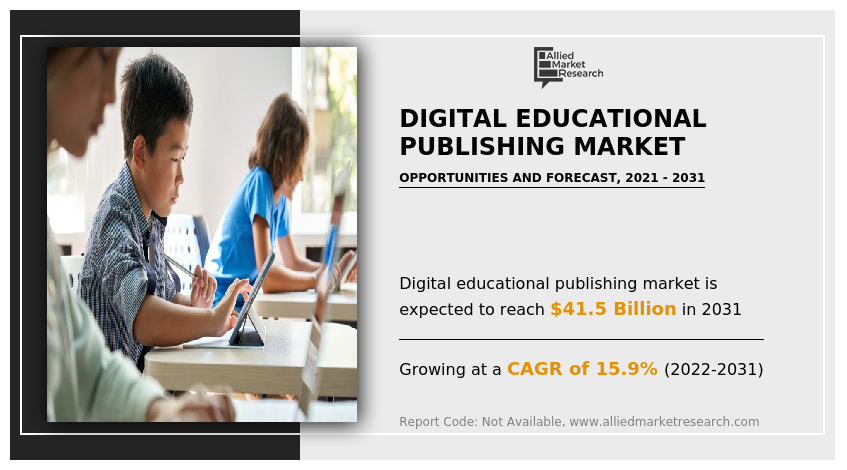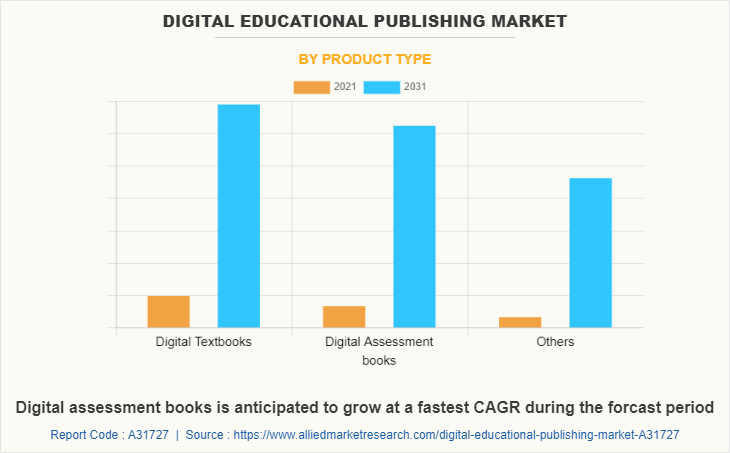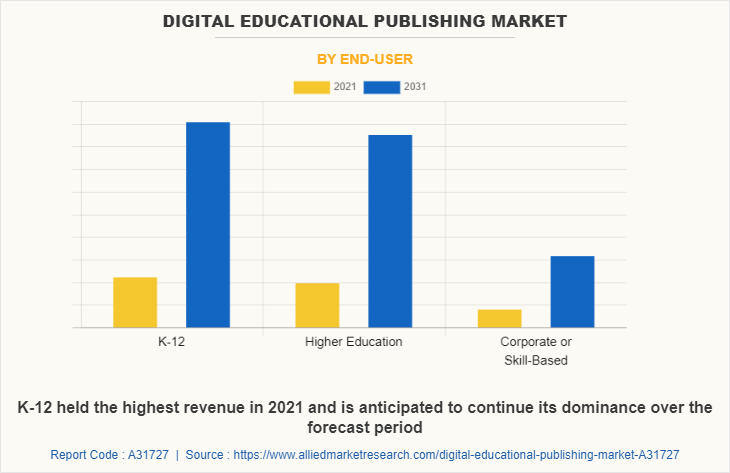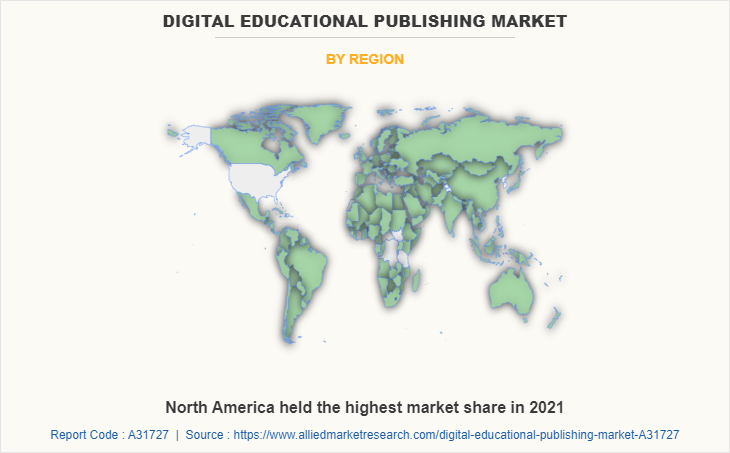Digital Educational Publishing Market Statistics, 2031
The global digital educational publishing market was valued at $9.9 billion in 2021, and is projected to reach $41.5 billion by 2031, growing at a CAGR of 15.9% from 2022 to 2031.
Digital educational publishing is the use of digital media to promote educational information. The material is available on various sites and is compatible with many devices such as laptops, smartphones, desktops, and tablets. The books offered by digital education are referred to as e-books, which let students access particular subscription payments. E-books are alternatives to printed books since they contain less printing expenditure.

Digital educational publishing learning provides the professors and instructors an effective technique to deliver lessons to the learners. Also, through online learning, the students and teachers have access to a wide range of materials such as videos, PDFs, and podcasts, and they may use all these media as part of their lesson plans. By broadening the lesson plan beyond typical textbooks to include internet resources, teachers may become more efficient educators. With virtual learning, learners have the opportunity to take classes in the privacy of their own homes. Not only do the learners save hours by not having to go to a physical location to take a class, but with online courses, they have greater choice in choosing the optimal time to study.
Availability of open-source resources might be a hazard for the growth of digital educational publishing market. Some disadvantages related to digital education include lack of social connection, restricted access to the internet, possibility of cheating, lack of self-motivation & improper proper time management skills.
Cutting-edge technology such as Augmented Reality (AR) is projected to play a significant role in fostering the expansion of the digital education industry. AR amplifies the actual environment with text, sound effects, graphics, and multimedia. Augmented reality is taking its niche in the education market and racing in popularity in schools and organizations internationally. Also, the increasing smartphone devices worldwide is one of the key reasons boosting the digital educational publishing market growth. The preferences of consumers for reading are gradually moving from conventional print formats to device-compatible formats as smartphones. This makes it possible for several top publishers or educational content providers to offer a wide range of digital content that can be accessible via internet-enabled smartphone devices like mobile phones and tablets.
The key players profiled in this report include Scholastic Corp., McGraw-Hill Education Inc., Georg von Holtzbrinck, Hachette Livre, Pearson, Cambridge University Press, Cengage Learning, John Wiley & Sons, Oxford University Press, and Thomson Reuters. Market players prefer inorganic growth strategies to expand into local markets.
The global digital educational publishing market is segmented on the basis of product type, end user, and region On the basis of product type, it is classified into digital textbooks, digital assessment books, and others. By end user, it is classified into K-12, higher education, and corporate or skill-based. By region, the market is analyzed across North America, Europe, Asia-Pacific, and LAMEA. The digital educational publishing market is segmented into Product Type and End-User.
By product type, the digital textbooks sub-segment dominated the global Digital Educational Publishing market share in 2021. Open-source e-textbooks may give the option to generate free, editable textbooks for essential topics or allow individual teachers the opportunity to create e-texts for their own courses. Such digital educational publishing factors in the digital textbooks sector are bound to create growth opportunities for the sub-segment during the forecast period.

By end user, the k-12 sub-segment was the highest contributor to the market share in 2021. During the forecast period. Government attempts to boost the quality of education at the K-12 level throughout the world is projected to propel the sub-segment growth. Furthermore, this sub-segment is driven by schools migrating from the old way to adding smart technology into learning settings. These are predicted to be the major factors affecting the Digital Educational Publishing market size during the forecast period.

By region, North America dominated the global market in 2021 and Asia- Pacific is projected to have the fastest growth during the forecast period. North America's market is estimated to lead the global digital educational publishing industry in terms of value, and this trend is expected to continue over the assessment period. The boom in online communications in this area is predicted to enhance market expansion.

Impact of COVID-19
- COVID-19 pandemic has unleashed a cascade of extraordinary occurrences that have touched every industry. With the continued spread of the new coronavirus epidemic, companies throughout the world are gradually flattening their recessionary curves by utilizing technology.
- The widespread development of the COVID-19 pandemic had a good influence on the digital educational publishing sector over the forecast period. Due to the effect of COVID-19, educational institutions have been closed, resulting in the substitution of schools and colleges with online learning.
- The firms over the globe are increasingly flattening their recessionary curve by using technology. This, in turn, is predicted to provide great potentials in the global market to boost the digital educational publishing market forecast demand.
Key Benefits for Stakeholders
- This report provides a quantitative analysis of the market segments, current trends, estimations, and dynamics of the digital educational publishing market analysis from 2021 to 2031 to identify the prevailing digital educational publishing market opportunities.
- The market research is offered along with information related to key drivers, restraints, and opportunities.
- Porter's five forces analysis highlights the potency of buyers and suppliers to enable stakeholders make profit-oriented business decisions and strengthen their supplier-buyer network.
- In-depth analysis of the digital educational publishing market segmentation assists to determine the prevailing market opportunities.
- Major countries in each region are mapped according to their revenue contribution to the global market.
- Market player positioning facilitates benchmarking and provides a clear understanding of the present position of the market players.
- The report includes the analysis of the regional as well as global digital educational publishing market trends, key players, market segments, application areas, and market growth strategies.
Digital Educational Publishing Market Report Highlights
| Aspects | Details |
| Market Size By 2031 | USD 41.5 billion |
| Growth Rate | CAGR of 15.9% |
| Forecast period | 2021 - 2031 |
| Report Pages | 270 |
| By Product Type |
|
| By End-User |
|
| By Region |
|
| Key Market Players | oxford university press, inc., hachette livre, Pearson plc, McGraw-Hill Education Inc., Georg von Holtzbrinck, Scholastic Corp., cengage learning, Thomson Reuters Corporation, John Wiley & Sons Inc., cambridge university press |
Analyst Review
The ease of access to the information within a pre-defined strategical approach, virtual reality convergence, and the integration of cutting-edge sophisticated technology are the driving forces in the global digital educational publishing market. Moreover, the increased popularity of online courses and distance learning is driving the digital educational publishing market growth. In several nations, the government sees education as a crucial duty to ensure that the general public has access to educational resources. Lack of awareness about digital educational publishing platforms due lack of digital earning infrastructure is estimated to restrain the market growth. Furthermore, the lack of access to seamless internet connectivity across many countries is estimated to hamper market developments. In addition, copyright and ownership problems are widespread. Recent advancements in cloud-based digital educational learning offer cross-platform accessibility to propel market growth. Due to the expansion of online learning platforms, social media accessibility, and the availability of a wide range of languages for the creation of educational content, the market offers significant potential opportunities to the workforce.
Among the analyzed regions, North America is expected to account for the highest revenue share in the market by the end of 2031, followed by Asia-Pacific, Europe, and LAMEA. An increase in online communications combined with hybrid and work-from-home learning model are the key factors boosting the popularity of digital educational publishing market in the North America region.
Increase in global usage of smartphone devices is one of the key factors fueling the expansion of the digital educational publishing market. In addition, governments across the globe are undertaking several projects to boost the usage of digital technology in the education sector, which are estimated to generate excellent opportunities in the digital educational publishing market.
The major growth strategies adopted by digital educational publishing market players are product launches and mergers & acquisitions.
Increase in demand for e-learning and m-learning from students and professionals is estimated to drive the adoption of digital educational publishing market.
The report provides an extensive qualitative and quantitative analysis of the current trends and future estimations of the global digital educational publishing market from 2021 to 2031 to determine the prevailing opportunities.
North America will provide more business opportunities for the global digital educational publishing market in future.
K-12 sub-segment of the end-use industry acquired the maximum share of the global digital educational publishing market in 2021.
Scholastic Corp., McGraw-Hill Education Inc., Georg von Holtzbrinck, Hachette Livre, Pearson, Cambridge University Press, Cengage Learning, John Wiley & Sons, Oxford University Press, and Thomson Reuters are the leading market players active in the digital educational publishing market.
K-12, higher education, and corporate or skill-based are the major the major customers in the global digital educational publishing market.
Loading Table Of Content...


